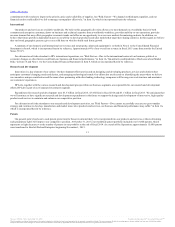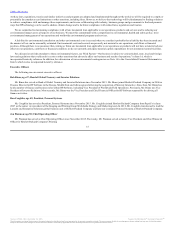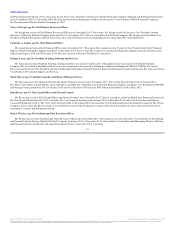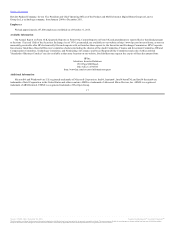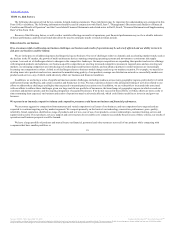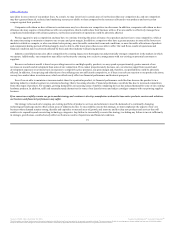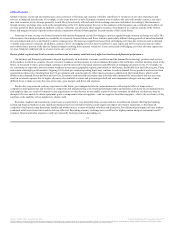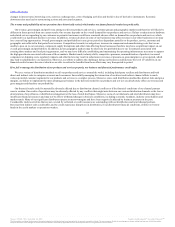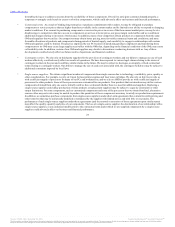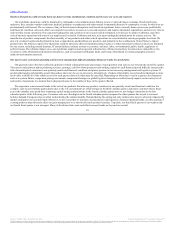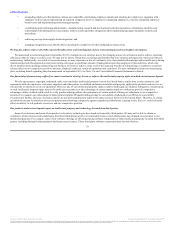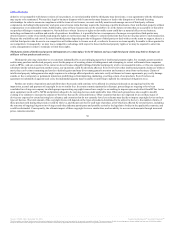HP 2015 Annual Report Download - page 22
Download and view the complete annual report
Please find page 22 of the 2015 HP annual report below. You can navigate through the pages in the report by either clicking on the pages listed below, or by using the keyword search tool below to find specific information within the annual report.
Table of Contents
The process of developing new high-technology products, services and solutions and enhancing existing hardware and software products, services and
solutions is complex, costly and uncertain, and any failure by us to anticipate customers' changing needs and emerging technological trends accurately could
significantly harm our market share, results of operations and financial condition. For example, to offset industry declines in some of our businesses, we must
successfully grow in adjacencies such as copier printers, maintain our strong position in graphics and execute on our strategy to grow commercial mobility
by providing specialized products and services to address the needs of our customers. We must make long-term investments, develop or obtain and protect
appropriate intellectual property, and commit significant research and development and other resources before knowing whether our predictions will
accurately reflect customer demand for our products and services. Any failure to accurately predict technological and business trends, control research and
development costs or execute our innovation strategy could harm our business and financial performance. Our research and development initiatives may not
be successful in whole or in part, including research and development projects which we have prioritized with respect to funding and/or personnel.
After we develop a product, we must be able to manufacture appropriate volumes quickly while also managing costs and preserving margins. To
accomplish this, we must accurately forecast volumes, mixes of products and configurations that meet customer requirements, and we may not succeed at
doing so within a given product's lifecycle or at all. Any delay in the development, production or marketing of a new product, service or solution could result
in us not being among the first to market, which could further harm our competitive position.
If we cannot continue to produce quality products and services, our reputation, business and financial performance may suffer.
In the course of conducting our business, we must adequately address quality issues associated with our products and services, including defects in our
engineering, design and manufacturing processes and unsatisfactory performance under service contracts, as well as defects in third-party components
included in our products and unsatisfactory performance or even malicious acts by third-party contractors or subcontractors or their employees. In order to
address quality issues, we work extensively with our customers and suppliers and engage in product testing to determine the causes of problems and to
develop and implement appropriate solutions. However, the products and services that we offer are complex, and our regular testing and quality control
efforts may not be effective in controlling or detecting all quality issues or errors, particularly with respect to faulty components manufactured by third-
parties. If we are unable to determine the cause or find an appropriate solution to address quality issues with our products, we may delay shipment to
customers, which would delay revenue recognition and receipt of customer payments and could adversely affect our revenue, cash flows and profitability. In
addition, after products are delivered, quality issues may require us to repair or replace such products. Addressing quality issues can be expensive and may
result in additional warranty, repair, replacement and other costs, adversely affecting our financial performance. If new or existing customers have difficulty
operating our products or are dissatisfied with our services, our results of operations could be adversely affected, and we could face possible claims if we fail
to meet our customers' expectations. In addition, quality issues can impair our relationships with new or existing customers and adversely affect our brand
and reputation, which could, in turn, adversely affect our results of operations.
We are exposed to fluctuations in foreign currency exchange rates.
Currencies other than the U.S. dollar, including the euro, the British pound, Chinese yuan (renminbi) and the Japanese yen, can have an impact on our
results as expressed in U.S. dollars. In particular, the economic uncertainties relating to European sovereign and other debt obligations and the related
European financial restructuring efforts may cause the value of the euro to fluctuate.
20
Source: HP INC, 10-K, December 16, 2015 Powered by Morningstar® Document Research℠
The information contained herein may not be copied, adapted or distributed and is not warranted to be accurate, complete or timely. The user assumes all risks for any damages or losses arising from any use of this information,
except to the extent such damages or losses cannot be limited or excluded by applicable law. Past financial performance is no guarantee of future results.



